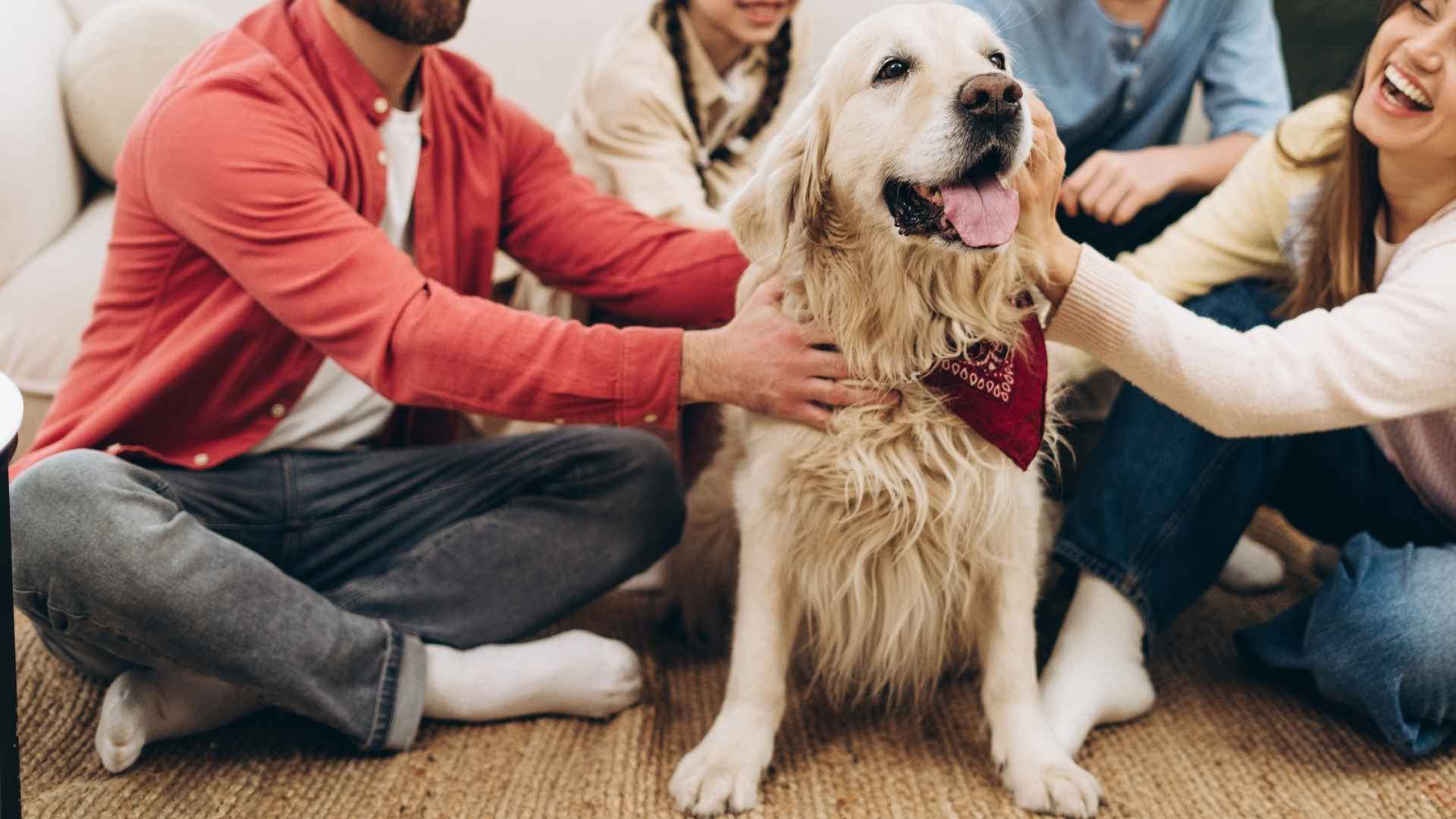Did you know that a dog’s presence can significantly lower stress levels? It’s not just their wagging tails and soulful eyes that provide comfort—it’s the deep emotional connection they create with their humans. When it comes to finding a furry friend who can offer more than just companionship, family emotional support dogs (ESA dogs) are in a league of their own.
These dogs don’t just bring joy; they help families cope with stress, anxiety, and emotional struggles, making them vital members of the household. Whether you’re looking for a cuddly companion to help ease the tough days or a loyal friend to share in life’s ups and downs, the right dog breed can make all the difference.
In this guide, we’ll explore the best emotional support dog breeds that offer unconditional love and support, making them perfect for families in need of comfort.
Family Emotional Support Dog Breeds
1. Golden Retriever

Golden Retrievers are among the top emotional support dogs, known for their calm, affectionate nature. Their intuitive ability to sense human emotions makes them a comforting presence during anxiety, stress, or emotional distress. Whether offering a quiet cuddle or simply staying close, they naturally ease tension and provide emotional stability.
With their soulful eyes and steady companionship, Golden Retrievers provide more than emotional support—they bring joy, connection, and comfort into everyday life. Their gentle loyalty makes them a trusted partner on the path to emotional healing.
Highly loyal and people-oriented, Golden Retrievers form deep bonds with their owners. Their consistent affection and nonjudgmental companionship help reduce feelings of loneliness or insecurity. They’re especially beneficial for individuals who need emotional support in both private and social settings.
As noted by ESA Doctors, Golden Retrievers make great emotional support animals due to their gentle, intuitive nature, large and comforting presence, and playful personality. They provide a sense of security for individuals with post-traumatic stress disorder and uplift their mental health through their affectionate and attention-seeking behaviour.
Goldens also offer non-judgmental companionship that is especially beneficial for children with autism or trauma. Despite their size, Goldens are incredibly gentle, making them ideal support animals for both adults and children.
This breed is intelligent and easy to train, responding well to routines and commands. Golden Retrievers can quickly learn tasks that support emotional well-being, such as grounding techniques during panic episodes or maintaining a calm presence in stressful environments.
Golden Retrievers offer balanced energy—gentle enough for quiet days but playful when encouragement is needed. Their calm, steady temperament suits people of all ages and lifestyles, from those with limited mobility to those managing high-functioning anxiety or depression.
Their presence naturally promotes healthy routines. Feeding, walking, and caring for a Golden Retriever encourages structure and daily activity, which can be especially helpful for people struggling with motivation or depressive symptoms.
2. Labrador Retriever
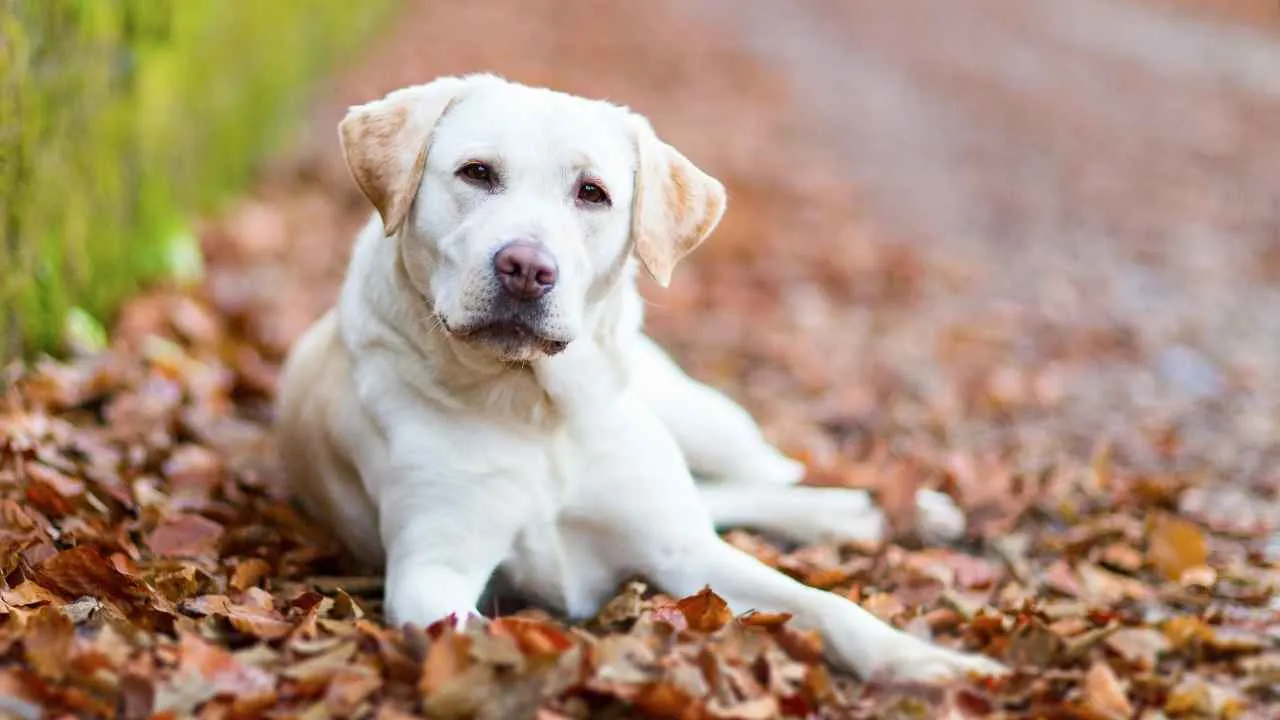
The Labrador Retriever is one of the most beloved dog breeds in the United States, known for its friendly temperament, intelligence, and energetic nature. These medium-to-large sporting dogs typically weigh between 55–80 pounds and stand 21–25 inches tall, with females usually on the smaller side. Labs have a strong, muscular build, a wide head and nose, and a distinctive otter-like tail, with coat colors in black, yellow, and chocolate.
Originally bred in Newfoundland as working dogs for fishermen, Labradors were later refined in England for hunting and retrieving. Despite nearly facing extinction in the 1800s due to local dog ownership laws that discouraged keeping female puppies, English breeders preserved the bloodline.
The breed gained official recognition from the English Kennel Club in 1903 and the American Kennel Club in 1907, quickly rising in popularity across both nations.
Labradors are extremely social and affectionate dogs, getting along well with children, other dogs, and even strangers. However, early supervision is still important when introducing them to new people or pets. Thanks to their eagerness to please, Labs make great therapy dogs, service animals, and in roles such as search and rescue, bomb detection, and hunting retrieval.
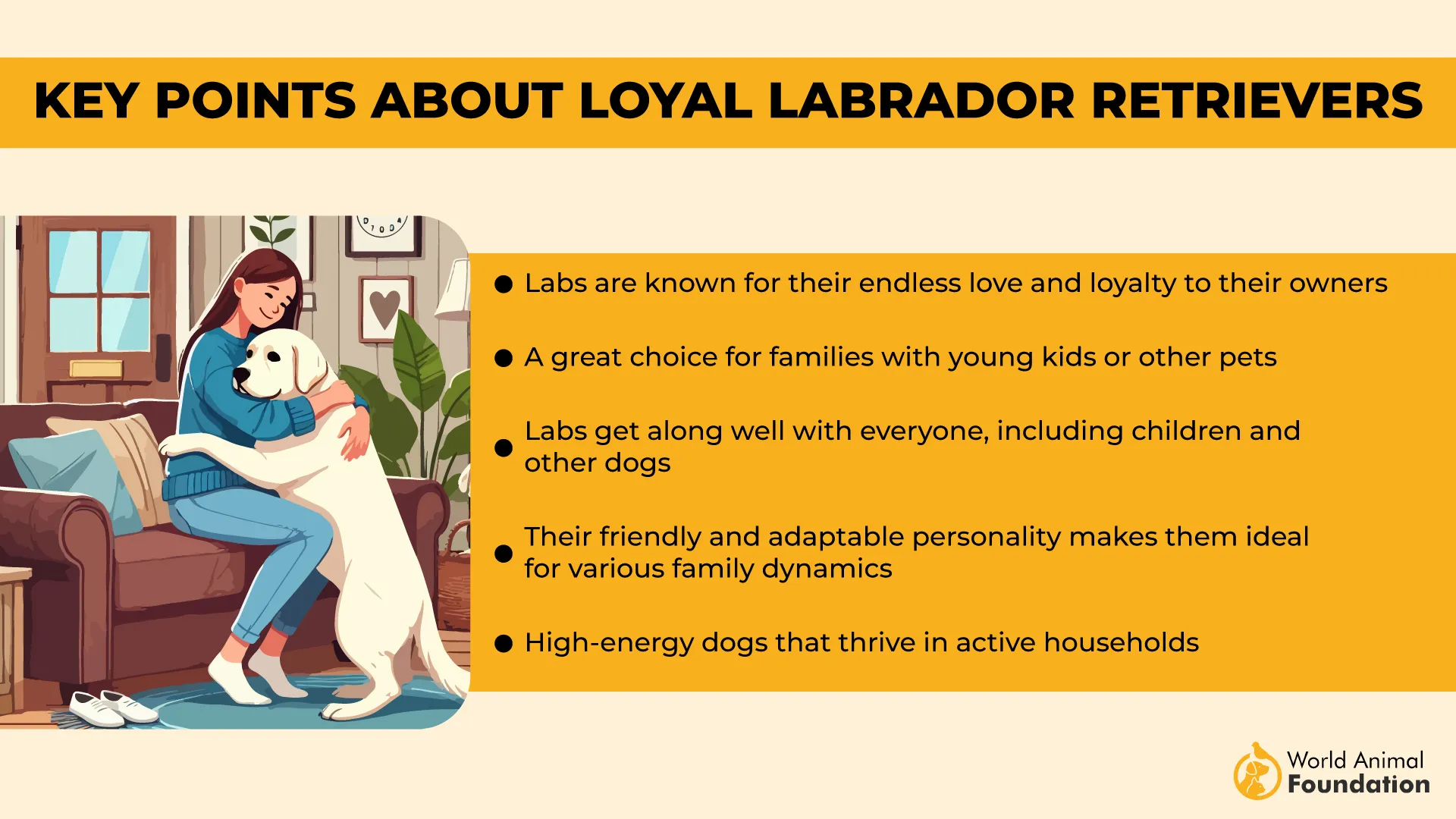
AKC states that one of the breed’s standout traits is its love for water. Labradors are built for aquatic activity, with webbed feet, a powerful tail, and a dense double coat that provides insulation and repels moisture. Their waterproof coat, while ideal for swimming, also sheds heavily, especially during seasonal changes, making regular grooming essential.
Labradors also display a natural oral fixation. Originally bred to retrieve game birds without causing damage, Labs developed highly controlled jaw muscles. This gentle mouth makes them capable of carrying fragile objects, like eggs, without breaking them. It’s not unusual for Labs to use their mouths affectionately, such as lightly gripping their owner’s arm.
An interesting trait of the breed is their high pain tolerance, which contributes to their effectiveness in rescue operations. Their keen sense of smell has even enabled them to detect certain medical conditions like blood sugar drops. The first dog to detect diabetic episodes was a Lab named Armstrong, who set a precedent in medical service work.
3. Cavalier King Charles Spaniel

The Cavalier King Charles Spaniel is beloved for its sweet, gentle, and affectionate nature. Known for being a cheerful and friendly companion, this breed fits seamlessly into many types of households, whether with families, seniors, or individuals. Cavaliers are sociable with both humans and other pets, and their moderate energy level makes them easy to manage indoors without being overly demanding.
While Cavaliers are moderately playful and generally easy to train, they’re also somewhat laid-back, enjoying cuddles as much as play. Their calm demeanor and low tendency to bark make them unsuitable as watchdogs, but ideal as indoor pets in quieter environments. This balanced temperament is a major reason they’re often considered the perfect house dogs.
Britannica states that the breed traces its name and popularity back to King Charles II of Great Britain, who was famously inseparable from his small spaniels. The term “Cavalier” came from his political supporters during the English Civil Wars. Centuries later, the breed remained favored by notable figures—U.S. President Ronald Reagan famously gifted one named Rex to his wife Nancy in 1985.
Originally bred as comfort and companion dogs, Cavaliers have naturally evolved into outstanding therapy animals. Their innate warmth and love for human interaction align perfectly with the qualities required in Animal Assisted Therapy work. Whether they’re retired show dogs or everyday pets, many Cavaliers excel in bringing emotional support and joy to those in need.
CKCSC states that to be a successful therapy animal, two key elements are essential: a dog with a loving temperament and a human partner willing to give their time and care. The Cavalier King Charles Spaniel is considered ideal in both regards, often forming deep emotional connections with people and bringing comfort through their gentle presence.
4. Poodle
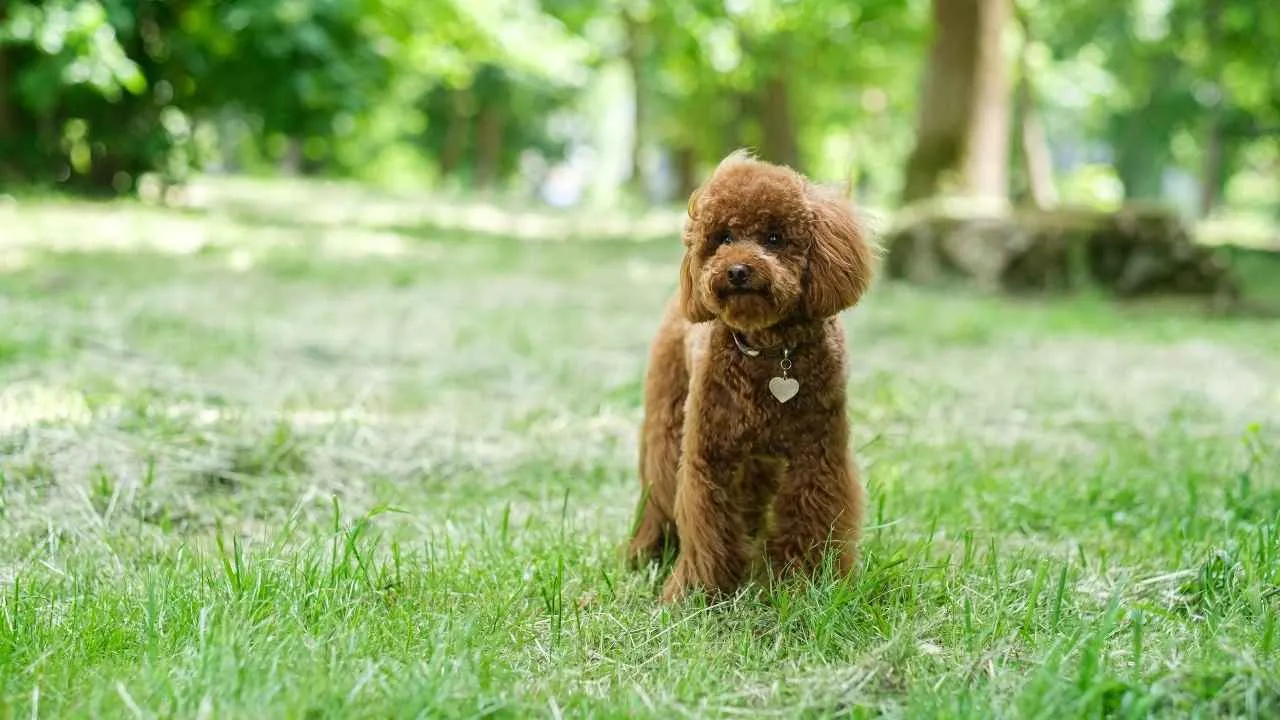
Often misunderstood as simply pampered pets, Poodles are actually highly capable working dogs originally bred for retrieving waterfowl. Their intelligence, agility, and versatility have made them one of the most respected breeds in the canine world. Poodles come in three distinct sizes—Standard, Miniature, and Toy—all sharing the same core traits and behavioral tendencies.
Poodles are known for their lively and affectionate nature. They are responsive, playful, and alert, making them excellent companions for active families. With early socialization, they get along well with children and other pets. While they may be slightly reserved with strangers at first, they quickly warm up and become loyal, loving members of any household.
This breed’s intelligence is one of its standout features. Poodles are quick learners, eager to please, and thrive on mental stimulation and physical activity. These traits make them ideal not only for obedience courses and specific training for service roles. Their keen awareness and trainability are also why standard poodles are frequently crossed with other breeds to create popular mixes like the Cockapoo.
Thanks to their unique coat, Poodles are often preferred by individuals with allergies. While no breed is entirely hypoallergenic, Poodles are considered low-shedding, which makes them a better option for people sensitive to pet dander. However, their curly coats do require regular grooming to avoid matting.
Beyond their physical abilities, these small dogs have a strong emotional intuition. They are naturally empathetic and often form deep emotional bonds with their owners. This sensitivity makes them excellent candidates for therapy and emotional support work, as they can detect human distress and respond with comforting behavior.
5. Pug
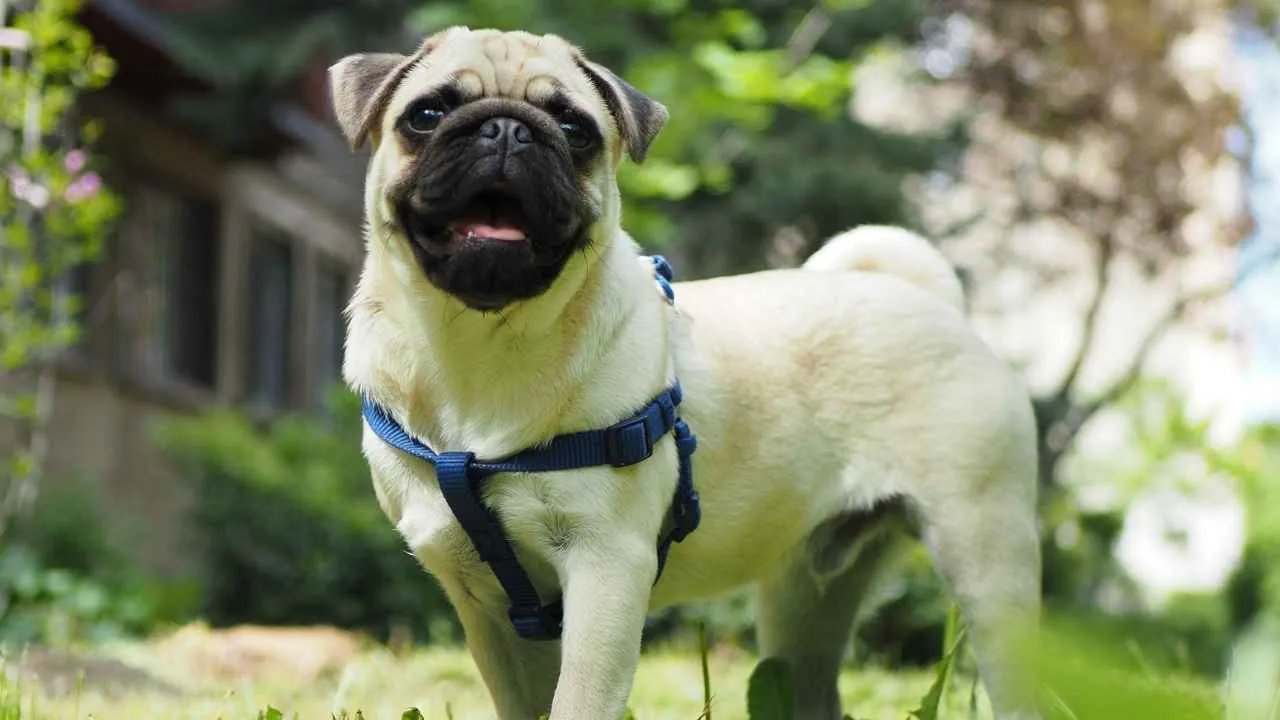
Pugs are one of the oldest known dog breeds, with roots tracing back to at least 400 B.C. in China. Originally kept as cherished pets by Tibetan Buddhist monks, they were valued for their calm disposition and affectionate nature. Over time, their distinctive features and playful temperament helped solidify their place as beloved companions around the world.
As per AKC, a hallmark of the Pug’s appearance is its deeply wrinkled face. These wrinkles weren’t an accident—Chinese breeders intentionally selected dogs whose foreheads resembled the Chinese character for “prince,” a symbolic trait of nobility. It’s also widely believed that the breed’s name was inspired by marmoset monkeys, known as “Pug monkeys,” which share a similarly expressive face.
Historically, Pugs have shown fierce loyalty. A notable example is “Pompey,” the Pug who saved Prince William of Orange from an assassination attempt in 1572, earning the breed a place in royal history. Another famed Pug, “Fortune,” belonged to Napoleon’s wife, Josephine, and is remembered for both smuggling messages from prison and famously biting Napoleon himself on their wedding night.
Despite their small stature, Pugs are sturdy and adaptable dogs. They make excellent family dogs, blending well with children, other pets, and even strangers. Their friendly and even-tempered nature makes them wonderful household companions, especially for those who can provide the attention they crave.
These little charmers are known for their expressive, clown-like personalities. Though often calm and cuddly, they also have bursts of playful mischief. They’re emotionally attached to their owners and can become anxious if left alone too often, which makes them best suited for homes where they aren’t left unattended for long periods.
Purina states Pugs are also known for the phrase “multum in parvo,” meaning “much in little.” This perfectly captures their essence—a compact body packed with charisma, humor, and heart. In Germany, they’re called Mops, and interestingly, a group of Pugs is affectionately called a grumble.
6. Shih Tzu
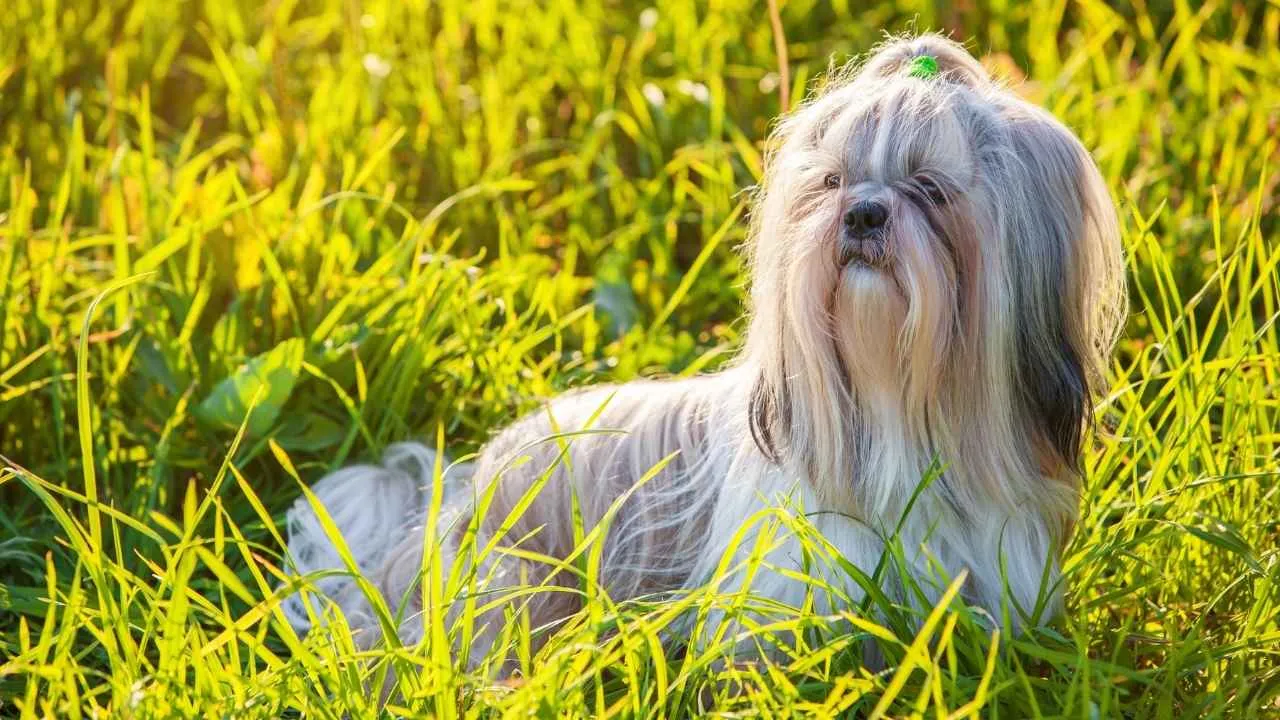
The Shih Tzu, though only officially recognized by the American Kennel Club in 1969, has deep roots in Chinese history. Its name, meaning “lion,” reflects its regal appearance and origins, possibly as a cross between the Pekingese and Lhasa Apso.
Britannica states that these dogs were cherished in Chinese royal courts and were later revitalized through a small group of 14 dogs in the 1930s, from which all modern Shih Tzus descend.
This toy breed is instantly recognizable thanks to its long, flowing coat, short legs, and large, expressive eyes. The Shih Tzu’s compact size and charming looks make it especially appealing for those living in apartments or smaller homes. They thrive in cozy environments and enjoy having a soft place to curl up.
Shih Tzus are known for their affectionate and cheerful personality. They bond closely with their humans and are generally friendly toward strangers, other pets, and children, making them a good fit for many family types, including seniors and city dwellers. Their playful spirit keeps them engaged, but they’re also more than happy to spend time lounging by your side.
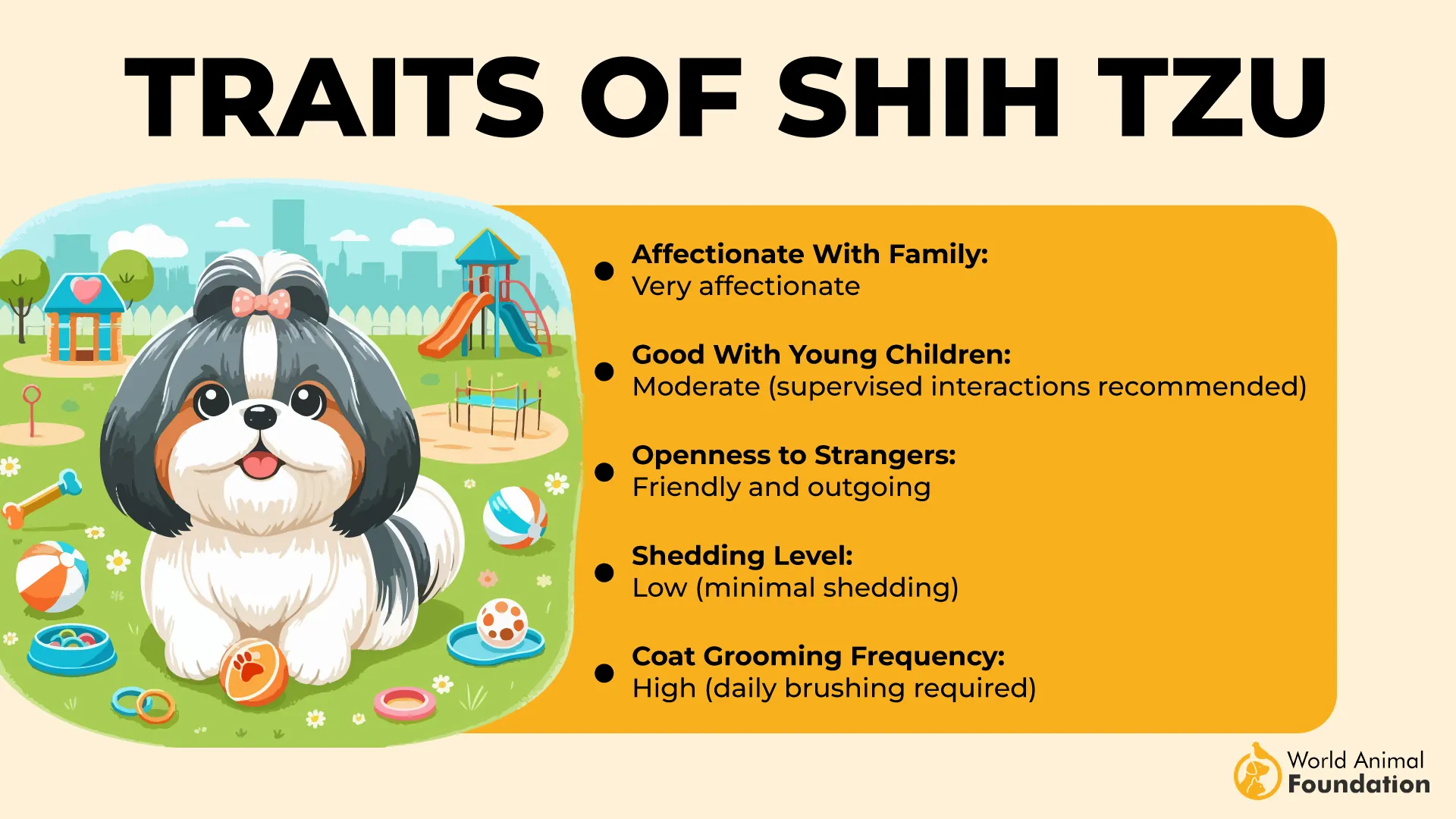
Shih Tzus can be well-suited for specific support roles thanks to their affectionate nature, intelligence, and adaptability. Their compact size makes them ideal for individuals with limited space, while their friendly and emotionally intuitive temperament helps them form strong bonds with their handlers, offering comfort and companionship.
Despite the physical limitations of dog size and its high-maintenance coat, Shih Tzus can be trained effectively for service work using positive reinforcement techniques. The training focuses on both basic obedience and specialized tasks tailored to the handler’s needs. With consistent, patient, and persistent training, Shih Tzus can become dependable service companions, challenging common misconceptions about their capabilities.
This breed’s easygoing nature, combined with a flair for companionship, has earned it a lasting spot among the world’s most beloved toy dogs. Whether serving as a playmate for gentle children or a loyal companion for older adults, the Shih Tzu offers warmth, charm, and a touch of royal elegance.
7. Collie
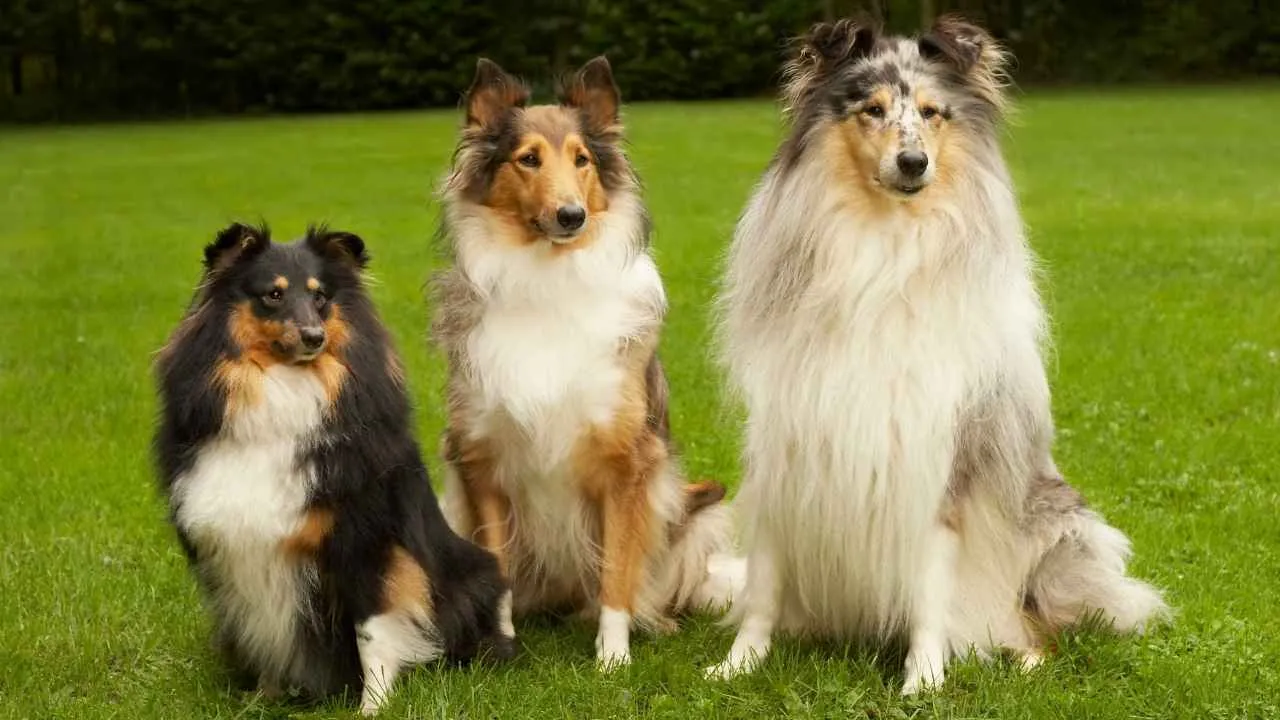
The Border Collie is an exceptionally smart and agile breed, originally developed in the borderlands between Scotland and England. Bred for herding and high-performance work, these dogs are often used in roles like mountain rescue and detection due to their remarkable trainability and sharp instincts. Their loyalty and eagerness to please make them ideal companions for active households.
Physically, Border Collies are known for their distinctive black-and-white or red merle coats, which come in either smooth or rough varieties. While coat length varies, all types require weekly grooming due to moderate to heavy shedding, especially during seasonal changes. Professional grooming is rarely needed, but consistent home care keeps their coats healthy.
These dogs are energetic, playful, and thrive in environments where they receive regular stimulation and interaction. Border Collies do well with children and other pets if introduced properly, though their boisterous nature may be better suited for families with older kids. Supervision is recommended during playtime to ensure safety for all.
The Rough Collie, closely related in appearance and temperament, is best known from popular culture and comes with a long, flowing coat, while the Smooth Collie has a shorter, sleeker coat. Both types share an elegant, wedge-shaped head and expressive, almond-shaped eyes. Coat colors range from sable and white to blue merle and tricolor, adding to their striking appearance.
Collies are incredibly affectionate and family-oriented, known for forming strong bonds with all household members. Despite their active outdoor nature, they enjoy relaxing indoors with their family. They are not suited to being left alone outside for long periods and adapt well to smaller living spaces if given enough daily exercise.
Training and mental stimulation are essential for Collie breeds. They thrive in obedience, agility, herding, and other canine sports. Early socialization and consistent, positive reinforcement help bring out their best qualities while addressing any independent streaks, especially seen in Rough Collies.
Conclusion
Choosing the right emotional support dog means looking beyond popularity and focusing on a breed’s innate ability to provide support through companionship and a calming presence. While not all ESA dogs are psychiatric service dogs, under the guidance of a licensed mental health professional, they can greatly ease mental health disorders like anxiety or panic attacks.
Breeds like the Poodle, Bichon Frise, and Yorkshire Terrier are among the best breeds for families, known for their gentle nature and therapeutic benefits. Thanks to protections like the Fair Housing Act and Disabilities Act, families can enjoy pet ownership without worrying about pet rent if they qualify.
Whether you choose from popular dog breeds, adopt through animal rescue, or need a dog that also supports physical and mental stimulation, the right individual dog, with proper training, can make a lasting difference in your family’s emotional well-being.


